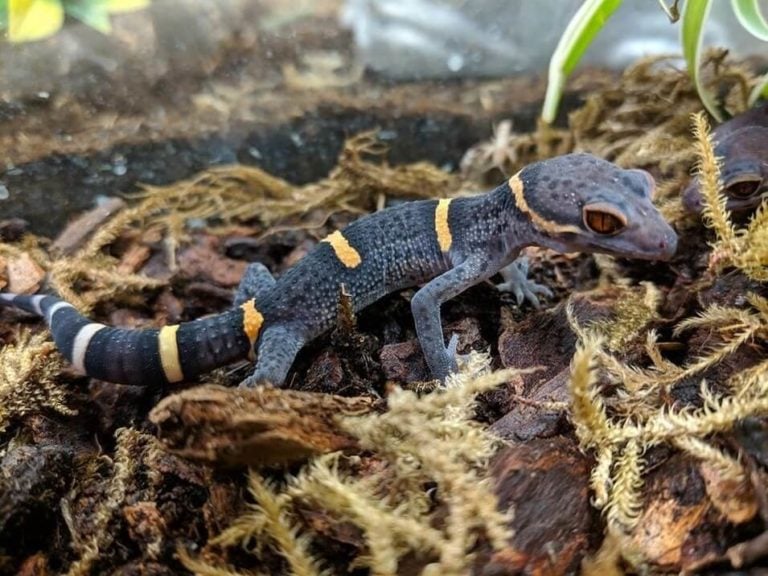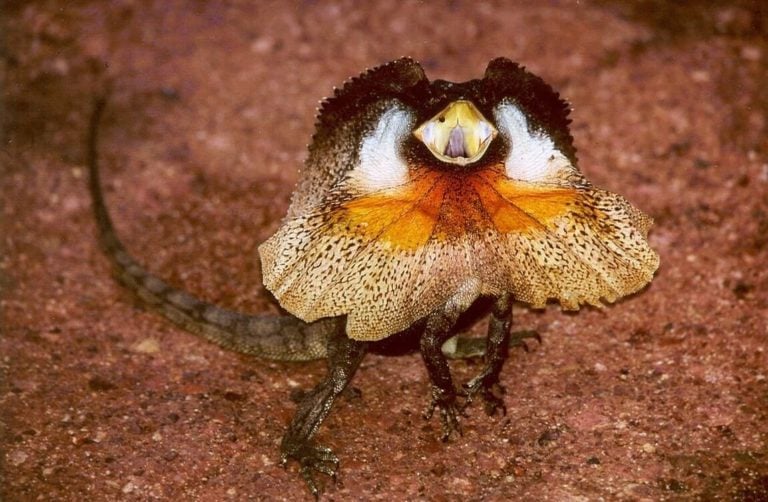Did you know an iguana’s diet could be the reason it’s acting sluggish – or living a long, vibrant life?
Experts say up to 80% of pet iguanas suffer from diet-related health issues. It’s a scary number, but here’s the thing: many well-meaning iguana owners just don’t have the right information.
Iguanas can live for a surprisingly long time! That’s about 15 to 20 years with excellent care.
Sadly, many iguanas don’t even make it half that long, and a lot of those problems start in their food bowl!
That’s because so much of the info on iguana diets out there is confusing, or even harmful. That’s why we’ve put together this guide – to clear away the myths and give you a simple plan for a thriving iguana.
Say goodbye to a sluggish grumpy large lizard! Ready to see your scaly friend perk up? Let’s dive in!
An Iguana’s Ideal Diet: A Guide to Greens, Treats, and What to Avoid
Iguanas, like the iconic Green Iguana, are herbivores. Their entire bodies are designed to tackle tough plant matter. Everything from their teeth (perfect for chomping leaves) to their specialized gut tells a story of plant-powered living.
Iguana Diet: The Key to Gut Health
What your iguana eats plays a HUGE role in how well its digestive system works. Generally, you should aim for a diet with these general proportions:
- 60-70% Calcium-Rich Leafy Greens: Think of these as the main course for your scaly friend.
- 20-30% Other Veggies: This is where you add variety for different nutrients and flavors.
- 10% or Less Fruit: The sweet stuff is an occasional treat, not a staple.
- Vitamin/Mineral Supplements: Iguanas need a constant source of calcium to keep their bones strong. Offer a good calcium supplement, and dust their food with it regularly. Mixing a high-quality vitamin supplement with powdered calcium carbonate (cuttlebone shavings) or calcium gluconate works wonders. Mix 1 part vitamins to 2 parts mineral (calcium). Read on to learn more about how much to give your iguana depending on age and gender.
Important Note: These numbers are a good guideline. Your iguana’s individual needs and preferences may vary slightly – so pay attention to them!
Staple Foods: The Backbone of Your Iguana’s Diet
Think of your iguana as a little vegetarian dinosaur. An iguana’s meals should be mostly made up of dark leafy greens.
That’s because their teeth are specially shaped to shred leaves, not for chewing meat.
Although some claims have been made that iguanas can incorporate small amounts of animal protein into their diet, there is currently no scientific documentation that shows any need for it.
Iguanas also have special bacteria in their intestines that break down tough plant matter.
This takes time, which is why iguanas love to lounge and digest!
Meanwhile, dark leafy greens are jam-packed with good stuff iguanas need: calcium for strong bones, fiber for healthy digestion, and much more.
- Types of Leafy Greens: Collard greens, mustard greens, turnip greens, dandelion greens (even the flowers are a treat!), bok choy (in small amounts), kale (in small amounts), endive, water cress – these are packed with the good stuff iguanas need. Not only are they full of calcium, but they have the right balance of other nutrients too.
- Safe Veggies: Snap peas, snow peas, bell peppers, asparagus, butternut squash, okra, green beans, even the occasional sweet potato (cooked, never raw!). These add variety and a boost of vitamins. Think of them like a sprinkle of seasoning on your iguana’s “salad”.
- Occasional Fruits: Small amounts of berries, figs, plum, mango, papaya… the sweetness is like a special dessert for your iguana. But use them sparsely– too much sugar isn’t good for their digestion, and can also negatively affect how well their immune systems respond to pathogens.
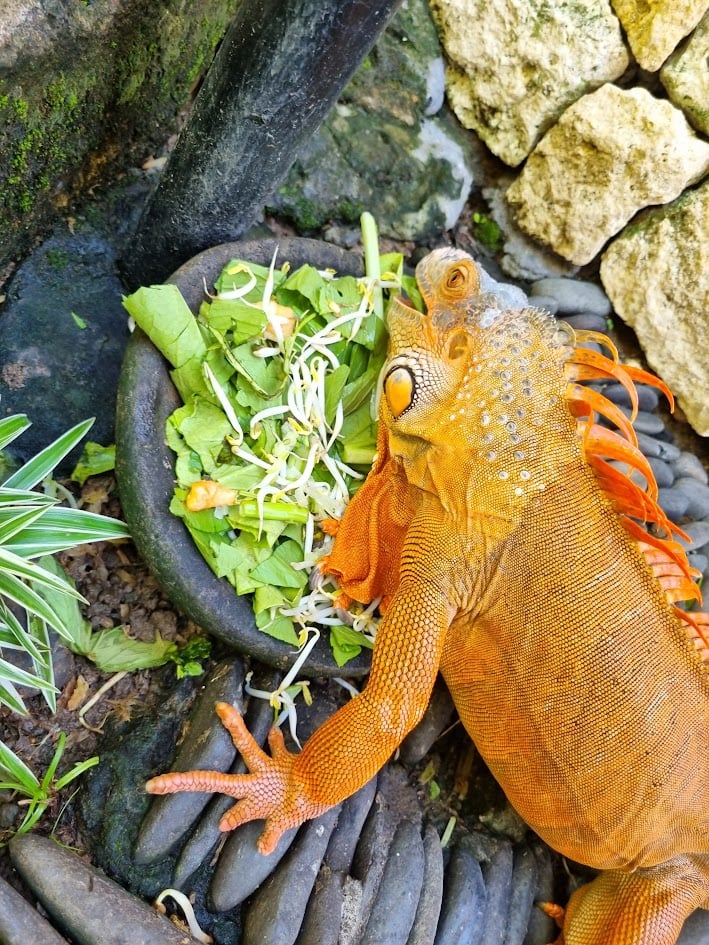
Treats: A Little Spice of Life
While dark leafy greens are the absolute best, why do iguanas sometimes seem to crave other things?
Of course, treats shouldn’t be the main course, but they’re great for enrichment and bonding with your iguana!
- Healthy Treats: Edible flowers (hibiscus, nasturtiums, dandelions – make sure they’re pesticide-free!) and small pieces of soaked hibiscus leaves are enticing additions to their regular food!
- How to Offer: Think of a treat like a treasure hunt. Hide a couple of flower petals in their salad, or hand-feed a piece of fruit while they’re basking – get creative!
- Variety is Key: Mixing in some other veggies and occasional fruits makes meals more interesting and fills in nutritional gaps.
Iguana Diet Danger Zone: What NOT to Feed Your Iguana
Look, we all want to spoil our pets, and those cute iguana eyes can be hard to resist. But when it comes to feeding your iguana, some foods are absolute no-nos.
Think of it like this: they might love pizza, but their bodies just aren’t built for it!
Foods to Avoid
- Meat, Insects & Animal Stuff: No chicken, no crickets, not even a sneaky bite of your burger! Animal protein is a huge no-no for iguanas and can wreck their kidneys.
- Dairy Deathtrap: Cheese, yogurt, all that good stuff…it’s poison for your iguana. They can’t digest it, leading to serious health problems.
- “People Food” Pitfalls: Salty snacks, processed foods, even many fruits are too sugary or have weird stuff in them that’s bad for iguanas.
- That Houseplant’s Not a Snack!: Many common houseplants are toxic to iguanas. Do your research before letting your lizard roam!
- Tofu: Although this plant-based protein might seem safe at first glance, its high-fat content can seriously hinder vital calcium absorption.
Iguanas: Built for Greens, NOT Everything Green
Remember, iguanas are herbivores – leaf-eaters all the way. But their systems aren’t made to handle just any plant. Some common houseplants have stuff in them that messes with their kidneys, bones, or can even be straight-up poisonous.
Toxic Houseplants to Keep Away
Here’s a rundown of some common plants that are a big NO-NO for iguanas:
- Philodendrons & Pothos: Popular and pretty, but those leaves cause mouth irritation, upset stomachs, the works.
- Dieffenbachia (Dumb Cane): This one’s seriously bad news. Chewing it can swell up your iguana’s throat, making it hard to breathe.
- Lilies: Gorgeous flowers, but lilies are super toxic to many animals, iguanas included.
- Oleander: Even a nibble can mess with your iguana’s heart. Scary stuff!
- Azalea, Buttercup, Daffodil, Tulip, Rosemary, and Sage should all be kept far away from your iguana as well!
Sneaky Hazards
- Pesticides: Even if the plant itself is safe, sprayed-on chemicals are bad news for iguanas.
- Fertilizer: The stuff you use to make plants grow can be harmful if your iguana munches on the soil.
“But They Eat Plants Outside!”
True, wild iguanas chow down on all sorts of stuff. BUT they’ve learned over time what’s safe, plus they’ve got a wider variety to balance out any toxins. Your pet iguana doesn’t have that luxury!
“But My Iguana Seems to Like It!”
Sure, your iguana might scarf down a piece of chicken, but that doesn’t mean it’s good for them! It’s like kids and candy – they love the taste, but it’s terrible for their health long-term.
Consequences of Munching the Wrong Greens
Think ignoring this is no biggie? Think again! Feeding your iguana the wrong stuff can lead to:
- Kidney Trouble: A common issue with iguanas fed the wrong stuff.
- Weak Bones: Without the right nutrients, iguanas can develop painful bone diseases.
- A Sickly Iguana: Vomiting, drooling, lethargy – not how you wanna see your scaly buddy.
- A Shortened Lifespan: The sad truth – a bad diet can cut years off your iguana’s life.
Important Note: Always double-check before giving your iguana anything new. Here’s a great online resource by Dr. Bruce Bogoslavsky that can help you out: Iguana Care Card.
The Ideal Feeding Schedule for Your Iguana
Now that you know what to feed your iguana, let’s dig a little deeper into the factors that make their nutritional needs change. How often and how much should you feed your Iguana depends on their life stage.
Remember, these amazing creatures aren’t one-size-fits-all! Think of your iguana kinda like a kid (a green, scaly kid). Just like their needs change as they grow, so does their ideal diet.
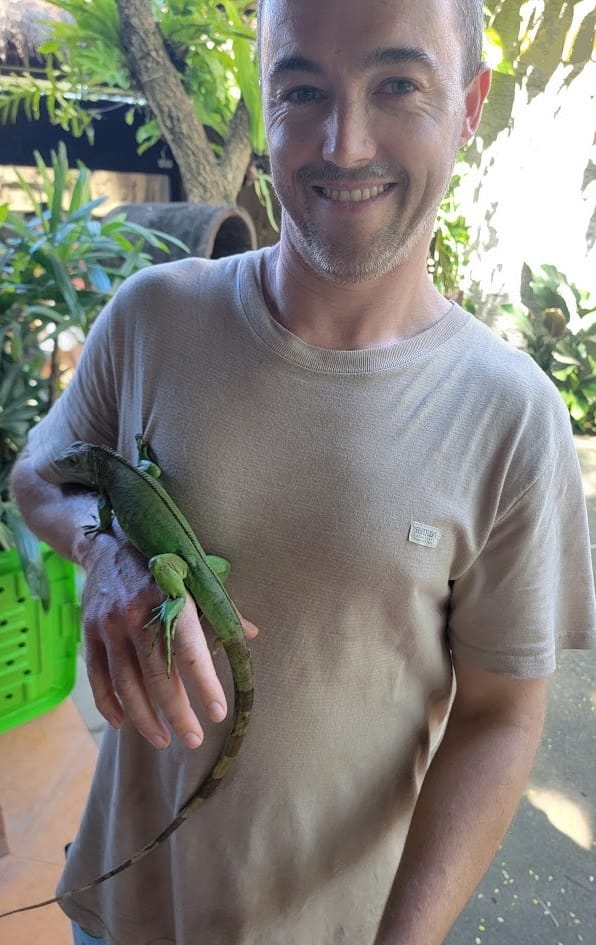
Lifestage Matters: The Iguana Diet Babies, Adults, and Seniors
- Baby Power: Picture those little iguanas growing like crazy! Hatchlings up to 14 inches in length should be fed twice daily, while juveniles up to 2.5 feet or 3 years of age should be fed once daily. They need a bit more protein in their early months to fuel all that growth. This is where a safe, high-quality protein comes in, specifically alfalfa pellets. But even for the babies, the majority of their diet should still be those leafy greens. In terms of vitamin/mineral supplements, they should be fed 1 small pinch of your mixture per feeding.
- Adults in their Prime: This is probably where your iguana is at – the sweet spot where you’ve got their staple diet down pat. Here’s where continue feeding once daily (though a day missed here and there is nothing to fret over). The focus now is on consistency and avoiding too many sugary treats, keeping them lean and active. There vitamin/mineral supplement intake should be about 1 full pinch per pound of weight twice weekly. Adult females can receive 1 full pinch per meal during their gestation months – roughly December through the first week of February.
- The Golden Years: As iguanas get older, their digestion might slow a bit. Softer veggies like kaboucha, acorn, and butternut squashes, as well as grated carrot tops, are easier on their system. It’s also super important to keep up their calcium intake to prevent bone weakness – ask your vet about the best supplement options.
Lifestage Matters: The Iguana Diet Babies, Adults, and Seniors
- Baby Power: Picture those little iguanas growing like crazy! Hatchlings up to 14 inches in length should be fed twice daily, while juveniles up to 2.5 feet or 3 years of age should be fed once daily. They need a bit more protein in their early months to fuel all that growth. This is where a safe, high-quality protein comes in, specifically alfalfa pellets. But even for the babies, the majority of their diet should still be those leafy greens. In terms of vitamin/mineral supplements, they should be fed 1 small pinch of your mixture per feeding.
- Adults in their Prime: This is probably where your iguana is at – the sweet spot where you’ve got their staple diet down pat. Here’s where continue feeding once daily (though a day missed here and there is nothing to fret over). The focus now is on consistency and avoiding too many sugary treats, keeping them lean and active. There vitamin/mineral supplement intake should be about 1 full pinch per pound of weight twice weekly. Adult females can receive 1 full pinch per meal during their gestation months – roughly December through the first week of February.
- The Golden Years: As iguanas get older, their digestion might slow a bit. Softer veggies like kaboucha, acorn, and butternut squashes, as well as grated carrot tops, are easier on their system. It’s also super important to keep up their calcium intake to prevent bone weakness – ask your vet about the best supplement options.
Supplements: Not a Magic Fix, but Important
Let’s be real, most of us aren’t going to perfectly recreate an iguana’s natural diet in the wild. That’s where supplements help fill the gaps.
- Calcium & D3: The Power Duo: As you now know, iguanas need calcium to build strong bones, BUT they also need vitamin D3 to help their bodies use that calcium. Most iguanas will need a calcium + D3 powdered supplement dusted on their food a few times a week. Refer to the vitamin/mineral supplement intake suggestions in the Lifestage Matters section of this guide.
- The Debate: There are other vitamin supplements out there. Some vets, such as those at Winter Park Veterinary Hosptial, recommend Nekton-Rep. A good reptile vet can advise if your iguana has specific needs, but for most healthy pets, a balanced diet is the priority.
Gut Health: The New Frontier for Happy Iguanas
This is where things get exciting! In recenet years, scientists have been learning tons about how the bacteria in an iguana’s gut impacts their overall health. Here’s what you need to know:
- Probiotics: You may have heard of these “good bacteria” for humans, well, reptiles can benefit too! Talk to your vet about possible safe probiotics to add into your iguana’s diet.
- Portion Control: A good rule of thumb is to offer as much fresh food as your iguana can eat in about 15-20 minutes. They’re smart and won’t overeat if they have a steady supply.
- Fiber Intake: Scientists have found that low- to medium-fiber diets are helpful for your iguana’s gut. Don’t try to feed your iguana high-fiber foods too often, as it will inhibit its gut’s natural fermentation processes.
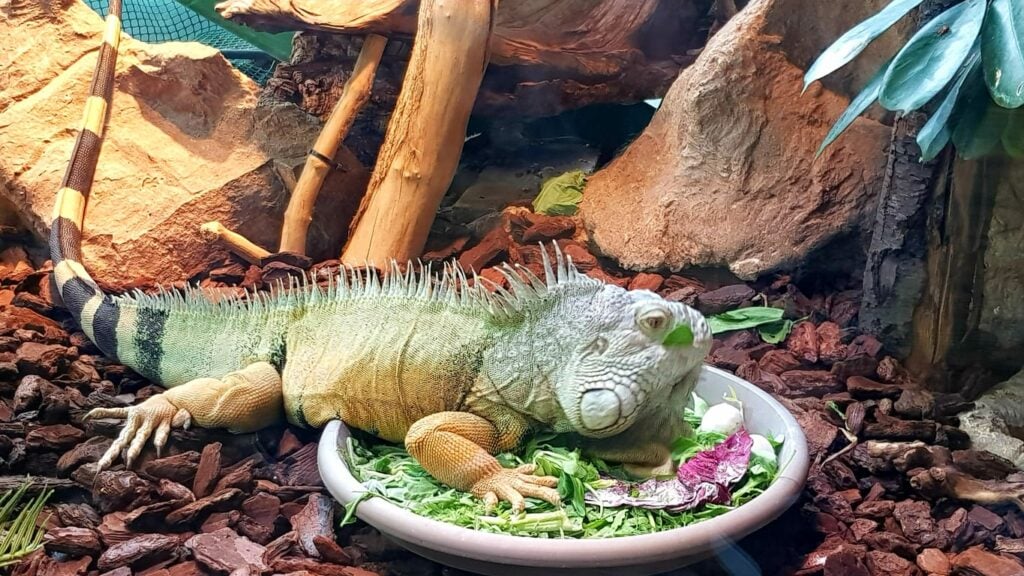
Practical Tips for the Everyday Iguana Owner
We all want what’s best for our scaly companions, but life happens! Fortunately, there are ways you can make that healthy iguana diet work in the real world, without turning into a short-order cook for a reptile.
Sourcing the Good Stuff: Where to Shop
- Beyond the Supermarket: While you can get some basics at the grocery store, don’t be afraid to explore! Farmers’ markets often have fresher, more interesting greens. Many pet stores now carry better quality produce, too. And if you’re in a warmer climate, online retailers may be your best bet for those harder-to-find iguana favorites.
- Grow Your Own (even if it’s small): Got a sunny windowsill, or a patch of yard? Try growing your own mustard and collard greens and your own snap/snow peas. Even a few pots of dandelion greens or some nasturtiums for a treat give you total control of what your iguana eats. It’s pretty rewarding to watch them munch on something you grew yourself!
- Regional Flavors: Live in the Southwest? Prickly pear cactus pads (with the spines removed, of course!) might become your iguana’s favorite. Florida folks may find their iguana loves tropical flowers. Learn what grows locally and is safe – it adds fun variety! But, as always, double check with your vet before introducing regional foods into your scaly friend’s habitat.
Meal Prep Like a Pro
- Wash and Chop Routine: Set aside an hour a week to wash, chop, and store a few days’ worth of “iguana salad.” This way, it’s grab-and-go during those busy mornings.
- Combos They’ll Love: Here’s a time-saver: find 2-3 “mixes” of greens and veggies your iguana enjoys. Rotate these mixtures so they don’t get bored, and you aren’t stuck reinventing the wheel each day.
- Freezing the Extras: Did you find an awesome deal on papayas, but your iguana only needs a little? Freeze small portions for future treats – less waste, and you’re always prepared!
Extra Tip: Keep a little notebook by your iguana’s enclosure. Note what they loved, what they left untouched, and any questions you have – perfect for your next vet visit!
The Bottom Line
Remember when you first brought your iguana home?
Whether it was that adorable little hatchling or a rescued adult, you made a promise to give them an amazing life.
A big part of keeping that promise is right there in their food bowl.
You’ve got the knowledge now to make the healthiest choices, and to see that spark in your iguana’s eye for years to come. Let’s hear it for thriving iguanas!



